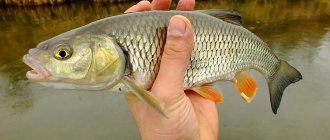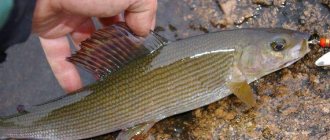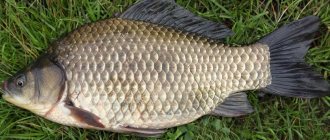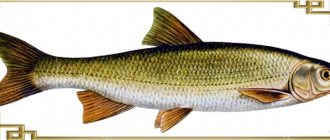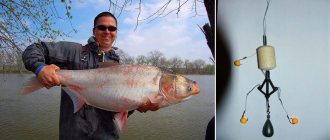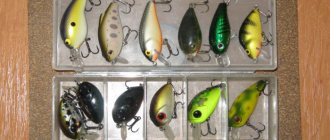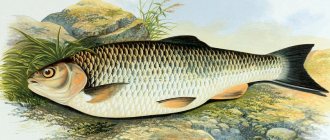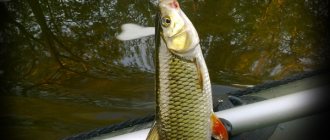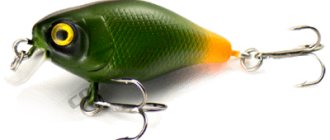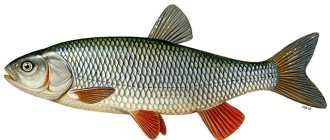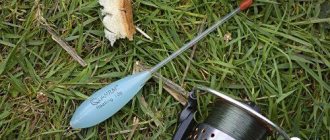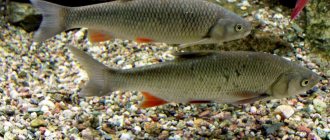When does the chub start to bite?
With the onset of autumn, the chub abandons its summer habitats and unites in flocks. And already in September, fish can only be raised from the bottom. They stay there all winter, in a sedentary state and do not feed.
In winter , the fish are practically inactive and do not feed. Therefore, at this time of year it is almost impossible to catch chub.
In summer, the chub is as vigilant and careful as possible. A good bite coincides with a massive emergence of insects. Therefore, to catch it in the summer, you need to be patient and dexterous.
In the spring , when flood waters begin to rise, the fish abandon their overwintering places and begin feeding. Spring is the best time of the year for chub fishing. The onset of spring brings with it advantages for successful chub fishing: 1. The bite can continue around the clock. The decline can only be observed between 12 and 2 am. 2.The water is not yet completely clear, which helps the fisherman and his gear go unnoticed. 3. This is the time of active search for food, and the chub begins to actively move around the reservoir.
Tackle
After the ice melts, many fishermen are quite successful in catching chub using regular donkeys, but every year chub fishing with a spinning rod is gaining more and more fans. This fishing cannot be compared with passive fishing in terms of excitement and fascination (and often effectiveness).
Of course, when it comes to fish such as chub, then, as a rule, spinning rods of the “light” and, to a greater extent, “ultralight” classes are used.
- For light use a rod with 3-15 grams of dough, up to 3 meters long,
- For ultralight rod test 0.5-7 grams, rod length – 1.8-2.1 m
- Ultralight tackle is equipped with a class 1000-2000 reel.
- The diameter of the fishing line or braid is from 0.12 to 0.18 mm.
It is precisely this delicate tackle that most often brings success.
Spinning baits common in summer and autumn often turn out to be useless in spring. In addition, the chub after wintering is quite slow, and this must be taken into account when choosing the pace of the retrieve. Let us note several of the most effective spring baits for chub.
Where to look for chub in spring
In spring, the chub prefers places with a smooth bottom, which is covered with clay or sand. The fish does not like fast currents and prefers places with a quiet or average flow. It swims at a depth of 1.5-2 meters. In fast-moving rivers, you should look for chub in remote backwaters. It’s worth trying to find them at the mouths of rivers and streams. Features of chub fishing in small rivers, ponds and lakes.
The following video examines in detail the question of where to look for chub , its habitat and conditions for successful fishing.
Small rivers
In small rivers, the chub is the dominant predator over other fish. And since it has no natural enemies other than humans, the chub feels quite comfortable in any area of a small body of water. An example of excellent spinning fishing for chub on a small river in the following video.
The chub is a lover of clean water and fast currents . That is why it is often found in small rivers.
Ponds and lakes
For chub, standing water is an unusual habitat. But sometimes it can be found in ponds and lakes. Catching this fish in still water is much more difficult. Due to the lack of current, fishing line and other fishing gear become more visible, and a suspicious chub will not be hooked. However, in still waters, fishing is easier, because the river chub is not used to fighting the current and offering resistance.
The happiness of catching the first chub in the spring
I go downstream, wade in and send the treasured fly to the quiet spot I like, right next to the bank. Exit, the fly disappears from the surface, a soft hook, and the delicate tackle bends under the pressure of a resisting fish. Can't be! The first successful bite of the new season! How many open fishing seasons are already behind you, and every time you rejoice at it like a child. Perhaps this is real happiness. A short struggle, and the chub, a little larger than the palm of my hand, ends up in my hand. Amazing! Inspired by success, I move to the next place, where I manage to catch another robber with red fins.
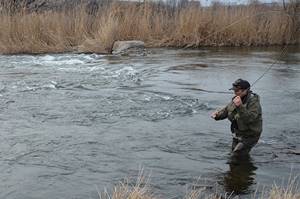
Tackle for catching chub in spring
Donk fishing and feeder
To catch this fish from the bottom, use a donk or a feeder. You can cast a couple of bottom rods and calmly wait for a bite. Let's look at the features of catching chub in the spring with a donk; feeder:
- Use only one rod if fishing in strong currents. Because the flow of water will carry away the bait and tangle the fishing line. You should cast your rods along the current.
- If you have a couple of bottom fishing rods, it is worth placing them at different points in the reservoir.
- Be very careful and quiet while fishing. The chub is a shy and cautious fish.
- The weight of the end sinker is determined by the force of the current.
- The diameter of the main line should be 0.5 mm.
- One or a pair of leashes 0.3-0.4 mm (in spring flood water the fish will not notice the fishing line).
- Hook No. 10, if the chub weighs half a kilogram, you can take a smaller size.
- An inertia-free reel is not suitable for catching this fish, since it will have to be readjusted before fishing. Which can lead to loss of catch.
- A good bait for such fishing is considered to be a lamprey larva, 10.5-11.5 cm in size. Small ones can be baited with several pieces. The larva is very tenacious, making it possible to cast the rod many times without changing the bait.
- A crawling worm can also be used as bait.
Spinning fishing
Fishing for chub with a spinning rod in the spring is considered the most sporting and trophy type of fishing. There are several rules for successful fishing:
- For spring fishing, a spinning rod with a short rod , maximum 2.4 m, is suitable.
- Casting should be done with light spinners and wobblers, so a rod with a 12 g weight is suitable. Take a closer look at the Norstream, Favorite, Major Craft models.
- The reel needs to fit a spinning rod, about 2500 in size. In general, it should not tangle the line. The best manufacturers are considered to be: Shimano, cheaper, but also good: Daiwa Shimano Nasci, Daiwa Revros.
- It is better to use 5-6 lb braided fishing line. The optimal ones in terms of price and quality will be: Sunline Super PE Varivas and High Grade PE.
- For a leash, you can take a monofilament fishing line about 0.3 mm in diameter.
Let's watch a video of chub fishing in the spring in May on a small river.
Habitats and behavioral characteristics
Among other things, spring chub fishing is interesting because many anglers start their spring-summer fishing season with it. Chub fishing in early spring usually begins one to two weeks after the ice cover disappears from the rivers . At this time, the big-headed predator leaves the wintering pits and begins to actively feed before the spawning period.
Starting from the moment when the chub begins to peck in the spring and before the start of spawning, its activity gradually, along with the warming of the water, increases and reaches its climax in the second half of April, early May. However, on the rivers of the southern part of the country, chub fishing is also active in March, in the last week of this first spring month.
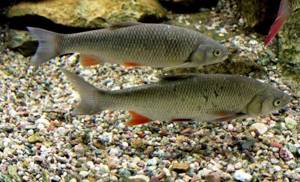
In those places, due to the rapid increase in air and water temperatures, the chub begins to actively gain weight somewhat earlier in early spring. Therefore, you need to determine when to catch chub in the spring not by the calendar, but by how quickly the river is freed from ice and the water warms up .
It is well known that in March, immediately after leaving the pits, chub begin to gather in schools, after which they gradually move to the spawning grounds. And these, most often, are small tributaries of rivers with a calm flow, well warmed by the spring sun, or shallow bays. It is to them that the chub usually strives in the spring.
Depending on where this place is located, the flock can sometimes take quite a long time to get there. Schools spawn at different times, depending on location and water temperature. But the spawning of the forehead itself occurs very quickly, it only takes one day.
During the period of its movement to spawning grounds, the spring chub can appear and attack the bait literally anywhere in the river, even in a backwater with coastal mud, where at other times it is practically not seen. But still, the most promising places to look for it are:
- Sections of rivers with riffles. In such places, chub do very well on spinning rods in the spring.
- Areas of the reservoir bordering bottom holes. Here, productive chub fishing in the spring is possible with almost all types of bait.
- Places where there are several submerged large boulders .
- In places where the river bed narrows , even if the bottom there is not rocky. Here, fishing for chub with a spinning rod in the spring can be quite effective until the end of May.
- Sections of the river under overhanging trees , where chub in the spring and at other times of the year feed on the larvae of a variety of insects. You can determine that it is here by frequent splashes on the surface of the water.
- On the border of areas with different flow intensities.
It can also be found near a flooded snag, next to the bridge supports, in the area of small islands. Most likely, catching chub with a spinning rod in March, after the ice has completely disappeared, will be successful at the exit from the pits, before the rifts.
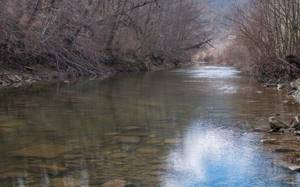
Chub fishing in April is quite active and can be successful in a variety of places. But still, after some warming up of the water, first of all you need to look for it in the places where various tributaries (eriks, streams, etc.) flow into the main channel , not far from the shore, where it is now easiest for it to find the food it needs.
In such places, the average chub usually does very well on a spinning rod in April and early May. In this case, there is no need for long-distance casting of baits; it will be much more effective to place them parallel to the shore at a distance of 2-3 meters from it.
Chub fishing in May will be more productive near holes and steep banks . Here the bighead usually rests for some time after spawning. After which, in the second half of the month, he begins to actively hunt throughout the entire water area of the reservoir, searching for food in various places. Therefore, fishing for chub in May should begin with identifying such promising places.
Lures for catching chub using a spinning rod
The most common baits for this type of fishing are wobblers and spinners.
Wobblers
Read more about wobblers for chub.
At the beginning of spring, while the water is not yet so warm, wobblers with a small vibration amplitude and passive play are suitable.
Yo-Zuri L-Minnow Zipbaits Rigge 35 Crank Smith Camion Magnum SR. Crank Bassaday Bun 30F
Good wobblers:
- Yo-Zuri L-Minnow
- Zipbaits Rigge 35
When the water temperature rises, the cranks will be used:
- Crank Bassaday Bun 30F
- Crank Smith Camion Magnum SR.
Video about chub coloring of wobblers:
Spinners
During the retrieve, rotating spoons produce vibration and noise that attracts fish.
It is better to choose models such as:
- Myran Wipp
- Mepps Aglia Long.
Mepps Aglia Long
Wiring tactics for successful chub fishing with a spinning rod
For successful fishing with a spinning rod, the main thing is to locate the chub’s stopping place and choose the appropriate bait. The nuances of fishing with a spinning rod: 1. Chub can lie in holes and come out from there only to feed. Therefore, it’s worth being patient and waiting for the chub to come out. 2. The fish attacks the bait without a typical strike. 3. It is better to conduct wiring across the current, under drift or in a loop.
How to catch chub on rivers in spring
How to catch chub in spring on small rivers. In small rivers in the spring, it is enough to choose a good place and, if you are careful, you can catch various fish such as crucian carp, roach, and bleak. The chub, by its nature, displaces small fish from its places, and if there is no bite, then one of the reasons may be the presence of the chub in these places. In small rivers, the chub is found in holes and depressions. Behind the drains of dams, spits. When the water level drops, there may be a lot of chub in such pits.
How to catch chub in spring on large rivers, because there the situation is completely different. It is best to fish with them in places where the depth begins, and is at least 3 meters at a distance of up to 15 meters from the shore. Such places should be level, without rolls or jumps. Another important part is that the sun should shine from behind. And you must always be careful, because in spring the chub is the most cautious fish.
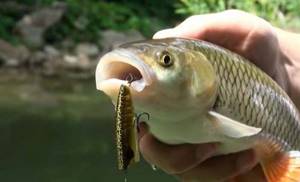
Places to catch chub on the river in spring, where to start fishing:
- Small riffles turning into a pool.
- Borders of shadows from trees and banks.
- Under bushes and trees.
- There are fallen trees and snags nearby.
- As soon as you come to the pond, first inspect it carefully, where the chub may be standing. All the ledges, the strength of the current, the rubble, the fallen trees, the trees hanging over the water. These are all potential fish holding areas. In such places there is a lot of food that falls from the trees or washes up with the current.
- The chub will stand in deep places, only occasionally coming out to shallow areas to hunt. Therefore, you should look for it there last. Also, first you need to fish areas with a current, where there is most food in the water flow. Make casts first to close range, then to distant areas.
- When casting, go upstream, because the fish always stands with its head against the current. This way you will be less visible to the fish and can safely fish all areas. After 30 minutes you can repeat the passage, by this time the fish will return to their places.
- Chubs stand in the water according to their age. The youngest stay at the top. Below are the average ones, up to 1 kg. At the very bottom, at great depths, the largest fish live. But they do not stand still there, they periodically rise up, swim around the territory and go into the depths. This means that a bite can occur at any time and at any depth.
How to catch chub in the spring with a fly rod
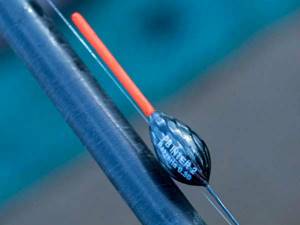
To catch chub with a fly rod, take a powerful eight-meter rod. Take a 0.18 mm fishing line, you will also need a leash, since there will be a lot of hooks. Depending on the bait, select a hook size from 6 to 12. Select a float so that it is stable at the casting site. A float weighing 6-10 grams is suitable if the fishing depth is approximately 3 meters; when fishing at shallow depths, about a meter, a float weighing up to 1 gram is suitable, and best of all without a keel and antenna. A bite manifests itself in a delay in the movement of the float or its movement to the side.
When fishing on small rivers, take a fishing rod with simple equipment. This is a float, a sinker, a hook. The sinker should be placed no further than ten centimeters from the hook. You can also use a jig in early spring.
Together with a fly rod and a wire rod, you can use a plug no more than 9 meters long. After all, a chub usually takes a bait in muddy water that floats in the water column or lies on the bottom. And such wiring is best done with a plug fishing rod. For its equipment, rubber with a diameter of 1.6 mm, monofilament with a diameter of 0.18 and a disk float of up to 10 grams are suitable. This will keep the bait where the fish are.
What bait to catch chub with
The first thing that a chub eats at the beginning of spring are gargles, swimmers, smoothies, ranatras, and water lovers. They all spread their wings after winter and begin their first and small journey. The habitats of such insects are shallow areas of the reservoir, where the water quickly warms up.
Also, when fishing in muddy water, a half-bottom is also suitable; I wrote briefly about fishing with it here . Bloodworms, worms, fry, bark beetles, and maggots can be used as bait. It is necessary to take into account that when fishing with bloodworms, your fish tank will be replenished with roaches and bream. A silver bream may appear in it if you catch it with maggots.
How to catch chub in early spring. In early spring there are slight difficulties with fry, so this method of fishing is a little difficult. Gudgeon and verkhovna are suitable as fry. You can start using bait when the water is clear. You need to use less bait than in summer.
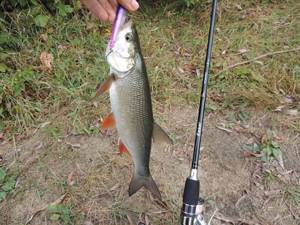
The bait needs to be made viscous so that the stream in the water is as thick as possible. It is advisable to add worms and clay to it; you can use bait for use in cold water and during currents. Balls are made from bait, which are thrown exactly at the place where the chub is caught. It is best to feed the chub before the bite begins, as this process will scare away the fish afterwards. And if you learn how to properly feed fish, then you will not be left without a catch.
The main thing for baits is that they are as similar as possible to insects in their behavior in the water. Chub are reluctant to respond to lures of shiny colors; such lures work well for pike, perch, and asp. But the chub prefers bait in matte shades. It is better to choose brown, black, green, burgundy colors. You can also choose baits with a combination of these colors. That's all. Write your comments whether you liked the article or not, and how you catch chub in the spring. See you in the next articles.
I wish you success in catching chub!
To Home Page.
Photos from catching chub in the spring using a spinning rod
The photographs clearly show the angler’s arsenal, which includes the wobblers shown above in the review.
Catching chub with a fishing rod
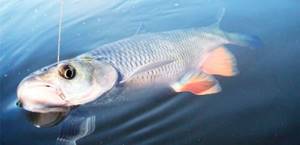
For productive fishing using a float rod, you need to select days with stable weather conditions, without steep pressure changes . Ideal days are days with a light wind , which ripples the water surface and helps the fisherman go unnoticed. When catching chub with a fishing rod, you should choose banks on which large trees grow, places where there are ponds with mud and whirlpools.
If you are a beginner, we recommend that you read the guide on how to properly equip a float rod.
The video shows and describes in detail the process of preparing and catching chub with a fishing rod in the spring on a small river.
Baits/attachments for float fishing
The chub is an omnivorous fish, so it can be caught using a variety of different baits. In spring, the cockchafer is considered one of the best. Read more about fishing with this type of bait. During the summer of beetles, fish can feed only on them, not recognizing other food. This will help you easily decide on the choice of nozzle.
Suitable before the beginning of summer:
- maggots;
- bloodworms;
- worms;
- cancerous necks;
- bread crusts;
- dough.
Maggot Bloodworm Worm
Conditions for catching chub using a float:
- For such fishing, only thin fishing line with a diameter of no more than 0.25 mm is suitable. Leash 0.2 mm.
- Hook with medium length shank No. 7; No. 8.
- We hang the load 10 cm above the hook.
- The fishing rod must be equipped with a reel. Since fishing in wiring is more effective.
- Take floats of dark colors that will be invisible in the water. A bulb float is suitable for this case.
Deep-sea wobblers (deeps)
In my opinion, when fishing for chub in cold water (especially before the beginning of May), the use of wobblers with DR-depth (deeps) or, more simply, deep-water ones is one of the most effective. Wobblers of this type have protruding shapes, a wide blade that is significant (up to 3/4) relative to the length of the body of the wobbler itself, located at an acute angle to it, which makes it possible, even with their small size (weight), to confidently drive these wobblers to 3–5 meter depths .
The stable reach of such layers of the water column by wobblers in the spring and precise work in them is determined by the fact that in the conditions of the calendar April (see types of baits), as well as during frosts and significant cold spells in the first ten days of May, the food supply of chub (bleak and juvenile white fish) and the chub itself descend into the middle layers of water and bottom horizons. Optimal placement of wobblers of this class “along an arc” or “for demolition” is effective because it is on them that we can drive deep-sea wobblers (deeps) to the maximum calculated depths. There is no particular point in shallowing the size of deep-sea wobblers during this period.
Wobblers with a body length of 6–7 cm are quite suitable, but in many cases it is advisable to correct their excess buoyancy (by gluing strips of lead, increasing the size of the tees), transferring the wobbler to the class of suspenders or even sinking ones. This correction of the load, in addition to increasing the casting range, allows you to reach other depth thresholds and better stability of work in the current, which is especially important during these fishing periods (as noted above). Often the chub easily attacks wobblers measuring 8–10 cm and, despite its small mouth, swallows them quite confidently. Nevertheless, the overall percentage of misses and idle attacks when fishing with such large wobblers increases quite noticeably.
Lure
You can make complementary foods yourself or purchase them at the store.
- Homemade can be one-component (bread crumb, boiled peas and corn).
- Store-bought complementary foods . This complementary food is good because it contains various flavor enhancers and flavorings that attract fish.
- Mixture . The most effective feeding for chub fishing is a mixture of store-bought and homemade feeding with the addition of bait elements (worms, maggots).
According to professionals, one of the elements of bait should be the component used for fishing. If you fish with maggots or worms, then it should be present in the bait.
Next is a little secret that fishermen have been using lately. It turns out that the chub is very successful in feeding on melted cheese bait!
Floating wobblers
Conventionally, we include all wobblers, regardless of shape, component elements and body volumes, with a depth of up to 0.3–0.5 meters. In my opinion, since May, the priority of using wobblers of this class has already definitely been seen both during daytime and during twilight (night) fishing. But in April, they are, by and large, only highly specialized baits used for catching chub in small quickly drying up shallow streams and channels, fishing under trees and bushes (the chub settles under them or picks up their color, broken fry, accidentally fallen insects), in conditions darkness or a lot of snags.
In addition to the main types of wiring used when working with such wobblers, we can also recommend their variety, designated as “free swimming”. In this case, fishing is carried out from a high steep bank, some kind of hydraulic structure (dam, bridge, towering spot, small island) above the entrances and exits of the pools, in conditions of a significant current - a jet.
After casting and falling onto the water, the floating wobbler, without any hint of braking of the cord, simply rushes or floats along the surface of the water or begins to spin freely in the return line, and reeling, which plays practically no role in this case, begins only after the wobbler leaves the boundaries area of interest to us. The bite and grip of a wobbler is always perceived only visually by the “splash” on the water and the disappearance of the bait.
The relevance of such a presentation is especially effective with wobblers, imitators (colors, shapes, proportions) and is clearly visible in cases where the chub feeds, preferring to simply pick up something from the surface. Regarding the presence of the effect of noise capsules inside the bodies (or lack thereof) of any wobblers, my opinion fits into a simple formula - quiet and empty wobblers almost always work to one degree or another, but wobblers that rumble like “an electric train coming towards you” will attract chubs interest more selectively.
Fish activity
March. As soon as the reservoir is freed from ice, the fish leave their wintering grounds and begin to actively search for food. During this period, fishing should be carried out in chub feeding areas. At the beginning of spring, baits should be lightweight, no more than 2 grams. Cast the bait with the current in mind, and when it is carried to the desired point, play with the bait a little. Since the chub will not be interested in a stationary target.
April. In mid-spring, fish begin to gather in schools, and the water becomes clearer. During the day, fish can change their location in the reservoir several times. Now for successful fishing, you need to be even more careful and carefully select bait and gear.
May. At the end of spring, a successful bite continues day and night. We select an area for fishing: snags, stones sticking out of the water and depressions of 1-2 m. At this time, bottom fishing is practiced, so the sinkers must be heavy. For baits, leeches, worms and larvae are good. During the period of mass summer of the cockchafer, you should give preference to this bait. Cast in such a way that the bait stays near the bottom or closer to the middle.
The beginning of the chub fishing season with a spinning rod
As the ice melts, the chub becomes more active and begins to feed among the first predators in our rivers. But the spring component of its fishing with a spinning rod on rivers with a natural temperature regime (without urban drains and industrial discharges) is often both difficult to predict and completely contradictory! The arrival of real warmth and spring at middle latitudes is usually quite predictable. By the end of the first ten days of April, most rivers open up and are full of water.
Nevertheless, in the last decade (with the exception of last spring), even the flood of the Oka was not strong and long-lasting, and on its relatively large tributaries the water became thoroughly cleared, and its level returned close to ordinary values (i.e., almost summer), often before mid-April. It is quite curious that even in conditions of high and completely unheated water in the daytime, chub can be caught quite tolerably, but in those places and sections of rivers (tributaries) where its clearness is maximum.
Another indirect factor in the success of chub fishing with a spinning rod during this period is high daytime temperatures. In the afternoon, when the upper layers of water warm up further, on warm and quiet evenings, chubs rise to the surface or approach shallow areas, becoming more active.
During frosts, if chubs feed, it is only sporadically and in short outings, while they almost never rise to the upper layers of the water column. Already from mid-April, the chub gradually begins to show twilight night activity. At first, he again feeds only during short outings and in very local areas.
Finding such places in deep water is really not easy, but a hint for finding them can be the presence of a clear boundary with a weakened and twisting current near drains and shallows, temporary obstacles consisting of large stones, dams, other barriers, as well as the daytime presence of chub beyond their remote perimeter. But at the same time, it is quite a standard situation when out of a pair of sections of the river that fall under the proposed description, only one will work in the dark, and the other “no less tasty” chub is consistently ignored!
As the water warms up and its level drops, the chub gradually expands the boundaries of the twilight-night zone of influence on most of its traditional habitats and increases the temporary (hourly) duration of the twilight hunt itself... Around mid-May, the first wave of portioned bleak spawning usually begins, at which time the chub is able to feed , without stopping, almost around the clock! Catching it during such periods is completely unpretentious, but after the same few days or a week or the arrival of another wave of cold or geomagnetic disturbances, the chub again begins to show its stubborn temper, and the hunt for this white predator on the rivers takes on familiar shapes and becomes interesting...
Wiring
Their main types have been described (described) many times and step by step in fishing periodicals and on the pages of specialized Internet forums. I don’t see any practical sense in focusing on them once again, or in offering anything else separately, however, in the description of some of the nuances of working with various baits (current situations on specific trips), they will be mentioned.
Chub loves chicken liver very much
The video shows a bottom rig that can be assembled to catch chub using chicken liver using a small rod.
Below is a simple diagram of bottom equipment that can be used in the spring and not only on small rivers to successfully catch chub using chicken liver .

Scheme of bottom gear for catching chub with liver
Chub responds so well to liver because it is juicy live food , which this omnivorous river inhabitant is so partial to.
After spawning
Usually this period coincides with the emergence of the cockchafer. By this time, the water has already warmed up enough, the fish have something to eat, and they naturally begin to move away from spawning and eat off. In May, the chub occupies mainly the upper layers of the water, picking up beetles and other insects falling into the water, as well as attacking small fish. You should look for the forehead during this period of spring:
- Under overhanging branches of trees and bushes.
- Along steep cliffs with hard ground.
- On shallow riffles and spits, preferably with a gristly bottom or submerged single branches and snags.
Read also: How to catch pike perch or beresh, some fishing tricks
Also, throughout the spring, and not only spring, the chub likes to stick to places where there are various hydraulic structures. He especially loves bridges, occupying places near the supports.
Quick tips for catching chub
- The chub is very suspicious, so while fishing, do not make noise or make sudden movements.
- A noticeable float will frighten the chub, so you should choose a float of muted tones.
- Large individuals become active as evening approaches.
- The best bait is a mixture of store-bought bait with homemade bait and parts of bait.
- As soon as a couple of successful bites have occurred, the fishing location should be changed.
- Spinning requires precise casting, so this type of fishing requires additional practice.
- For bottom fishing you need a lightweight bait. Which will be comfortable to “play”.
- For successful fishing, use a float rod to feed several places in the pond at once.
- The favorite bait of the chub is the cockchafer. This kind of fishing requires long casting with bait retrieved.
- The chub likes to hide in various shelters: holes, sunken trees, stones.
Advice from our experienced professional colleagues
- The chub can clearly see from the water what is happening on the shore; you must approach the reservoir carefully and try not to make loud sounds;
- Floats that are too bright make the chub suspicious, and he will not peck at them;
- Large chub are most active in the evening and during twilight;
- The chub’s favorite bait is white bread mixed with a bite activator;
- Effective fishing with a float is only possible when baiting several places in the reservoir at once;
- After several fish have been caught, you should change the place of fishing;
- The chub prefers to stay in various types of shelters: holes, flooded trees, etc.;
- Fishing with the cockchafer requires long casting with a long swim of the bait;
- Bottom fishing tactics require playing with bait, choose the lightest equipment;
- If you have insufficient experience in spinning fishing, additional training is required, since this fishing method requires the most accurate casts.
